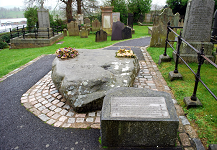A Word of Encouragement from Elizabeth Rice Handford
St. Patrick’s grave at Downpatrick How exciting it is to find out that what you thought was just a pleasant fairy tale about a brave hero turns out to be genuine, satisfying historic truth. That’s what happens when you hear St. Patrick’s story.
You know all about him, right? You wear green on March 17 because it’s St. Patrick’s birthday—maybe. Four-leaf clovers are lucky. St. Patrick said so. There are no snakes in Ireland. St. Patrick drove them into the sea.
sea.
It’s true that four-leaf clovers are rare (one in 10,000), and it’s true St. Patrick used the shamrock (with three leaves) to teach people that God is a Trinity; three in one. But lucky if you find one? No. True, there are no snakes in Ireland, but there were no snakes in Ireland before St. Patrick arrived, just as there are no snakes in New Zealand, Greenland, nor Hawaii.
The truth about St. Patrick is more fascinating than the myth. He was born in England about 386 AD. His father and grandfather were Roman citizens connected with the church. But Patrick knew nothing about God’s Word or His plan of redemption.
When he was just 16 years old, pirates from Ireland kidnaped Patraick and sold him as a slave to an Irish farmer. His owner mistreated him terribly. He was sent into the dangerous hills to take care of sheep, and there he lived in solitude for six long years.
But in his loneliness and deprivation, Patrick turned to the Lord Jesus. He remembered what he’d heard about the Bible and began to spend time in prayer and meditation. In the sixth year of his captivity, he heard God say, “Go to the eastern sea. Men in a ship will take you home.” So he walked all the way across the wilds of Ireland until he came to the shore of the Irish sea. There he found a ship owner who agreed to take him home.
Once home again, Patrick immersed himself in God’s Word. As he prayed for guidance for his life, God reminded him of the terrible spiritual condition of the Irish people. God seemed to be telling him to go back to the very people who had tortured him. He knew they were eternally doomed if they didn’t hear the Gospel. But that was too much to ask: he’d been so abused! Must he go? God said “Yes,” so Patrick responded, “Yes.”
This is no myth. It’s wonderful reality: Patrick deliberately chose to love the people who had tormented him. He went back to Ireland. Literally thousands came to trust Jesus as their Savior through his preaching. They called him “Saint” Patrick. He prayed this prayer:
Christ be with me, Christ be within me,
Christ behind me, Christ before me.
Christ beside me, Christ to win me,
Christ to comfort and restore me.
This is the secret of Patrick’s change of heart. Because Christ came to win Patrick, because He comforted him in his exile and restored him to preach the Gospel, his life is one long hymn of joy and service.
St. Patrick is buried at Cathedral Downpatrick in Northern Ireland. To see his grave, climb the high hill above the city; see the Irish Sea to the east. If you wonder why a huge slab of rock covers the actual grave, it’s because it stops pilgrims from scooping up handsful of earth from his grave to take home.
I am enthralled with the story. But I find it convicting as well. Do I love the people Jesus loves, even when they are unloveable? St. Patrick did.
